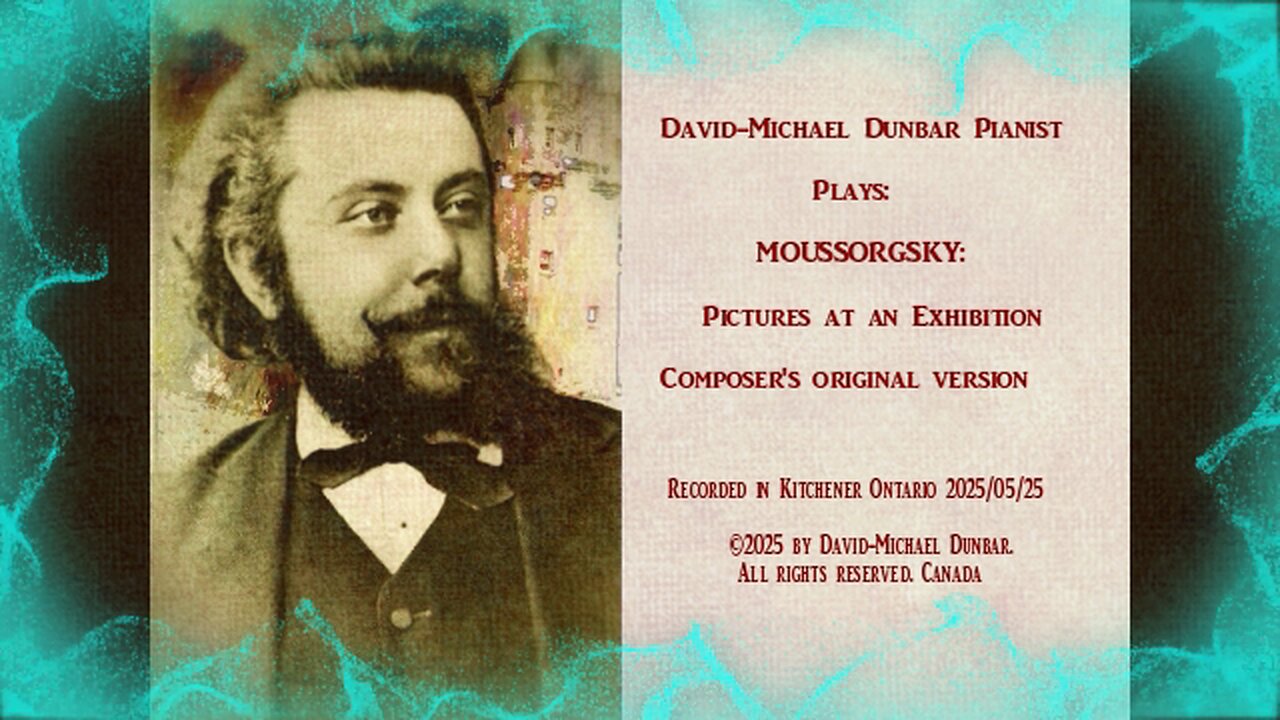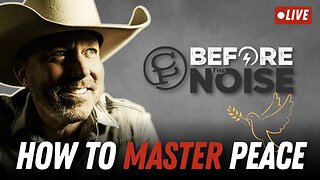Premium Only Content

MOUSSORGSKY: Pictures at an Exhibition, David-Michael Dunbar Piano
MOUSSORGSKY: Pictures at an Exhibition - Composer's original version
Pianist David-Michael Dunbar
Promenade.
Moussorgsky represents himself walking through the gallery, and the odd 5/4-6/4 meter is not only typically Russian but may stand for the visitor's uneven and indecisive ambulation.
1. Gnomus.
A grotesque figure of a little wooden nutcracker is seen in the first picture. The imaginary fits and starts, grunts and screeches of the child’s toy depicted by Hartmann come vividly and a bit frighteningly to life.
Promenade.
2. The Old Castle.
“A medieval castle,” Stassov wrote, ‘before which stands a singing troubadour.” The song is interminably repeated above a droning bass, until at the close the troubadour seems to call out, “Did you hear me in there?
Promenade.
3. Tuileries.
Children chat and argue, gaily and angrily, in the famous Parisian gardens. No Promenade is required this time, since the next picture hangs right alongside.
4. Bydlo.
The word means “cattle” in Polish. An old and battered oxcart plods along while the driver sings his mournful tune.
Promenade.
5. Ballet of the Chicks in Their Shells.
Here is something that even the finest-quality chicks can only do in a ballet—for which Hartmann’s sketch was designed.
6. Samuel Goldenberg and Schmuyle.
This is one of the most pointed and graphic caricatures in musical literature, realistically portraying an argument between two Polish Jews from the Ghetto of Sandomierz near Warsaw. Goldenberg’s pompously rejects the helpless pleadings of poor Schmuyle.
7. Limoges, the Market Place.
The gossip of the milling women at their marketing chores is animated and more than a little poisonous.
8. Catacombs
The movement is in two parts: a powerful, solemn introduction, subtitled “Roman Sepulchre,” and an ecclesiastical transformation of the Promenade theme. The composer called the latter “Cum mortuis in lingua mortua” (‘With the dead in a dead language”), and in a note on the original manuscript mused that Hartmann’s creative spirit led him toward the skulls, “which are illuminated gently from within.”
8. The Hut on Fowls’ Legs.
This is the old Russian legend of the witch Baba Yaga, who lives in a wildly spinning domicile. The artist’s drawing represented a large clock in the shape of Baba Yaga’s hut. Where a witches’ brew is being prepared. When the grim dance can get no wilder, the music suddenly veers off into a grand finale:
10.The Great Gate at Kiev.
Hartmann had made several designs for an archway and stone entrance to the city of Kiev, with a belfry tower that would be crowned by a gigantic cupola in the form of a Slavic helmet with pointed peak. The grandiose theme, resembles the Promenade theme as well as a Russian hymn, and there is another national chorale to be heard before the uniquely powerful climax with full forces and chiming bells, brings Moussorgsky's, Pictures at an Exhibition to a brilliant close.
-
 8:58
8:58
Colion Noir
2 hours agoHe Installed a Forced Reset Trigger at a Gun Range… and Got Arrested | What You Need to Know
1.15K6 -
 LIVE
LIVE
Badlands Media
8 hours agoBadlands Daily: October 22, 2025
1,027 watching -
 LIVE
LIVE
Wendy Bell Radio
5 hours agoKing Of The Trolls
7,467 watching -
 14:00
14:00
It’s the Final Round
8 hours ago $0.02 earned💰NBA Best Bets🔥Player Prop Picks, Parlays, Predictions FREE Wednesday Today October 22nd 10/22
261 -
 LIVE
LIVE
LFA TV
11 hours agoLIVE & BREAKING NEWS! | WEDNESDAY 10/22/25
3,614 watching -
 1:00:40
1:00:40
Chad Prather
10 hours agoHow To Live An UNSHAKEABLE Life!
46.4K17 -

The Chris Salcedo Show
13 hours ago $4.43 earnedDems Only Like Violence Directed At Conservatives
24.7K6 -
 DVR
DVR
Welcome to the Rebellion Podcast
13 hours ago $0.61 earnedHappy Hump Day - Welcome to the Rebellion Podcast Live 10/22
10.1K -
 8:29
8:29
Freedom Frontline
15 hours agoFox News Analyst EXPOSES Obama and Hillary’s Dirty Secret
20.4K19 -
 21:34
21:34
Jasmin Laine
18 hours agoReporters STUNNED as Carney’s “No Deal Coming” LEAKS—Billboards EXPLODE Nationwide
25K30